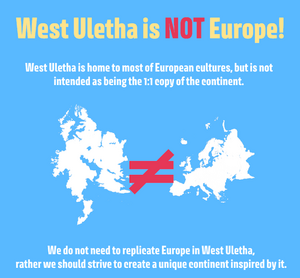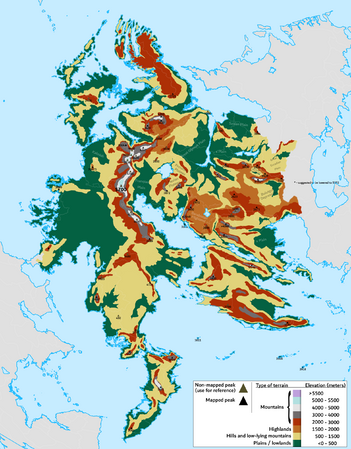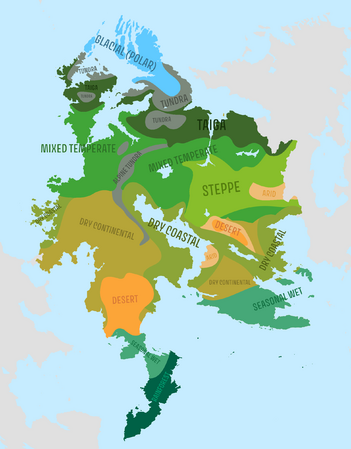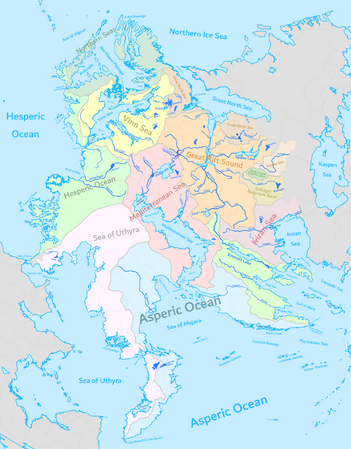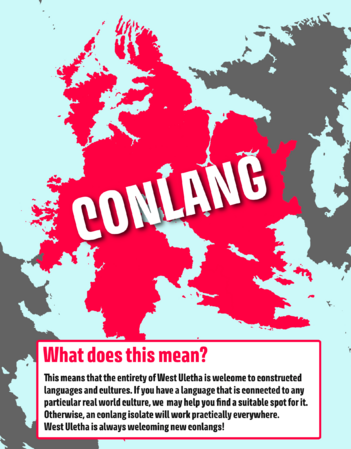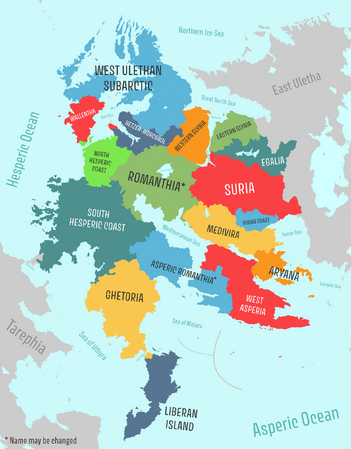OpenGeofiction:West Uletha
West Uletha is the western half of the largest continent on OGF - Uletha. The eastern half is East Uletha. With great size comes great diversity in geography, culture, climate, geology, history, etc. West Uletha is imagined as the home of most European cultures including English, French, German, Italian, Polish, Portuguese, Russian, Spanish and many more. Along with those, it features certain non-European cultures including those from the Middle East, Southern Asia, Central America and the rest of the world. Finally, it is also home to many fictional languages that users have created.
The subcontinent is home to a vast number of biomes and landscapes. Dominated by the temperate zones, it also features large swats of the mediterranean biome, as well as a sizeable amount of taigas, tundras, steppes and tropical rainforests. The rest of the subcontinent is composed of hot deserts, polar deserts, glacial terrain, alpine tundra, and all other kinds of biomes.
West Uletha is incredibly large, being home to the northernmost point of land in the world, while also having land south of the Equator. As of the 21st of March, 2024, it features 146 independent countries.
It is worth mentioning that West Uletha is NOT supposed to be a 1:1 copy of Europe and was and will never be imagined as such, however there are certain similarities between the two areas. The subcontinent is coordinated and managed by administrators Bixelkoven and Alessa.
Overview map
Loading map...
Maps of West Uletha
- West Uletha (as of 03 May 2024)
Regions
- Regions of West Uletha (as of 03 May 2024)
West Uletha is split into 17 sectors, numbered from 1-17, which designate areas with cultural similarities. These can be identified in the first two digits of West Ulethan territory codes (for example: UL17x is a territory in sector 17, the Iviran Coast region).
Homeland countries
West Uletha is home to most of the countries known as 'homelands'. These are nations that serve as the cultural and historical origins of other countries in the OGF world, primarily through colonization. Many countries in Archanta, Antarephia, and Tarephia are envisioned as former colonies, and West Uletha is where most of their founding nations are based. These homeland countries are large, influential, and were once colonial empires. Most of them are collaborative projects and are observed by the continental administrators.
No user is allowed to own a territory which would act as a homeland of the cultures mentioned below, but it is allowed to own a country which has a similar culture to one of them. Those countries are:
| Country | Inspiration from the real world | Collab page |
|---|---|---|
| Collab page / Forum page | ||
| Collab page | ||
| Collab page / Forum page | ||
| Territory is not a collab | ||
| Collab page | ||
| Naphon | Collab page | |
| Collab page | ||
| Collab page / Forum page | ||
| Collab page / Forum page | ||
| Veliticia | Collab page / Forum page |
Some countries that act as homelands, but aren't officially considered as such nor are they designated as such by the admin team, include:
- Balam-Utz - Mayan culture and language
- Beldonia - Slovenian culture and language
- Demirhan Empire - Turkish culture and language
- Drabantia - Czech culture and language
- Dregolesia within Geklinia-Dregolesia - Ukrainian culture and language
- Garlis - Romanian culture and language
- Kalkara - Maltese culture and language
- Larcetany - Catalan culture and language
- Malesoria - Albanian culture and language
- Mallyore - Croatian culture and language
- Navenna - Venetian culture and language
- Saave - Estonian culture and language
- Silland - Various Sami cultures and languages
- Zalivnia - Serbian culture and language
